Volker S 960-1 User Manual
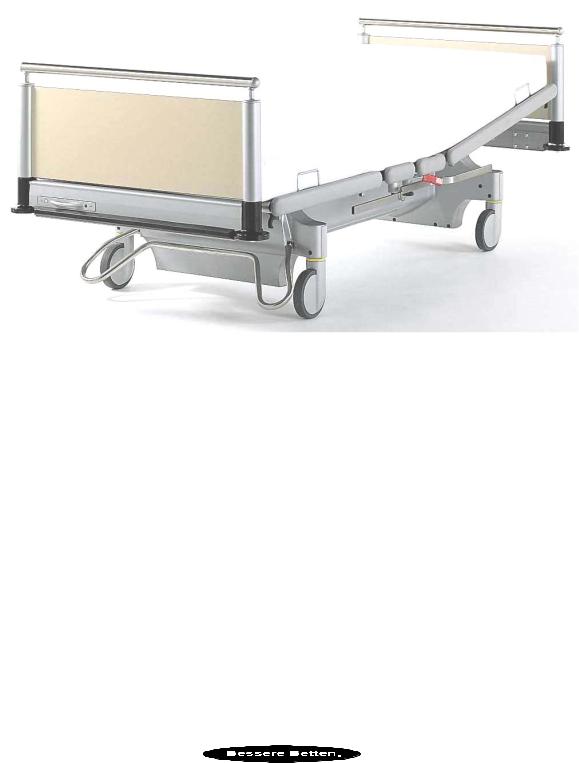
Völker Hospital Bed
User’s Manual
Model S 960-1
Edition: 2002-12-C
Völker AG 2002
Völker AG
Wullener Feld 79
58454 Witten
FR GERMANY
Tel.: ++49-(0)2302-96096-0
Fax: ++49-(0)2302- 96096-16
Mail: info@voelker.de
Internet: www.voelker.de
All rights reserved. Reproduction and copying in whole or in part prohibited. We reserve the right to carry out changes by reason of technical developments. The contents of this document are subject to change without prior notice.
Customers are advised to consult their sales representative before placing an order.
20020116
G - 16

Völker hospital bed |
User’s Manual |
Model S 960-1 |
|
|
|
|
|
Foreword
We congratulate you on your choice of a Völker hospital bed and would like to thank you for your confidence in our company and its products.
Before purchase, we are sure that you received detailed information and advice that convinced you of the many benefits of our hospital beds – benefits that in this configuration are truly unique.
The fact that a Völker hospital bed – in spite of its many functional features and technical refinements – does not look like a piece of sterile institutional equipment undoubtedly made your decision to purchase all the easier.
This user’s manual is intended to provide you with information on the technical features of Völker S 960-1 to help you to get the most out of its many functions.
Michael Hüppe
Chairman
Völker AG
Edition: 2002 May.-C
Page 3 of 80

Völker hospital bed |
User’s Manual |
Model S 960-1 |
|
|
Contents |
|
|
|
|
1. |
GENERAL REMARKS ....................................................................... |
|
6 |
|
1.1. |
Copyright .......................................................................................................... |
|
|
6 |
1.2. |
Warranty and liability....................................................................................... |
|
6 |
|
2. |
SAFETY REGULATIONS ................................................................... |
|
7 |
|
2.1. |
German medical products law (MPG) §22, Section 1 ....................................... |
7 |
||
2.2. |
Intended use ..................................................................................................... |
|
|
7 |
2.3. |
Incorrect use .................................................................................................... |
|
|
7 |
2.4. |
General safety instructions............................................................................... |
|
9 |
|
2.5. |
Electromagnetic/-static interference ............................................................. |
|
10 |
|
2.6. |
Before using the bed for the first time............................................................ |
|
10 |
|
2.7. |
Checking the operational safety and condition of the beds ........................... |
10 |
||
2.8. |
Position of the hospital bed............................................................................. |
|
11 |
|
2.9. |
Four-castor central braking system................................................................. |
|
11 |
|
2.10. |
Height adjustment ........................................................................................... |
|
11 |
|
2.11. |
Safety frames - Danger of entrapment............................................................ |
|
11 |
|
2.12. |
Cleaning and disinfection ................................................................................ |
|
11 |
|
2.13. |
Service and maintenance................................................................................ |
|
12 |
|
3. |
DEFINITIONS AND TECHNICAL DESCRIPTION .............................. |
13 |
||
3.1. |
Definitions ...................................................................................................... |
|
|
13 |
3.2. |
Technical description...................................................................................... |
|
14 |
|
4. |
EXPLANATORY NOTES FOR CARERS............................................. |
|
20 |
|
5. |
REVIEW: TYPES OF PATIENT POSITIONING.................................. |
21 |
||
6. |
OPERATIONAL UNITS.................................................................... |
|
22 |
|
6.1. |
General operating instructions....................................................................... |
|
22 |
|
6.1.1. |
Safety class .................................................................................................... |
|
|
22 |
6.1.2. |
Operating interval........................................................................................... |
|
22 |
|
6.1.3. |
Batteries......................................................................................................... |
|
|
22 |
6.1.4. |
Built-in safety cut-out ..................................................................................... |
|
22 |
|
6.2. |
Review: Bed functions .................................................................................... |
|
23 |
|
6.3. |
Putting bed into service for the first time (initiation)..................................... |
24 |
||
6.3.1. |
Location.......................................................................................................... |
|
|
24 |
6.3.2. |
Mechanical initiation ...................................................................................... |
|
24 |
|
6.3.3. |
Electrical initiation.......................................................................................... |
|
25 |
|
6.4. |
Operation with handset .................................................................................. |
|
27 |
|
6.5. |
Operation of electrical functional modes ...................................................... |
|
28 |
|
6.5.1. |
Adjustment of back section ............................................................................ |
|
29 |
|
6.5.2. |
Adjustment of upper leg section..................................................................... |
|
30 |
|
6.5.3. |
Adjustment of lower leg section (raised lower leg) ........................................ |
30 |
||
6.5.4. |
Height adjustment of bed ............................................................................... |
|
32 |
|
6.5.5. |
Trendelenburg and reverse trendelenburg positioning .................................. |
34 |
||
Edition: 2002 May.-C
Page 4 of 80

Völker hospital bed |
User’s Manual |
Model S 960-1 |
|
|
6.5.6. |
Sitting position (cardiac) ................................................................................ |
|
35 |
|
6.5.7. |
Voltage compensator cable connection.......................................................... |
|
36 |
|
6.6. |
Operation of mechanical functions................................................................. |
|
37 |
|
6.6.1. |
Four-castor central braking with total & directional locking facility ................ |
37 |
||
6.6.2. |
Mechanical fast release of back section, CPR function ................................... |
38 |
||
6.6.3. |
Use of safety frames ....................................................................................... |
|
39 |
|
6.6.3.1 |
Operation of safety frames .............................................................................. |
|
39 |
|
6.6.3.2 |
General warning on the use of safety frames................................................... |
|
43 |
|
6.6.4. |
Removal of headboard and footboard ............................................................ |
|
45 |
|
6.6.5. |
Wall buffers .................................................................................................... |
|
|
45 |
6.7. |
Operation with carers' keyboard ................................................................... |
|
46 |
|
6.7.1. |
Description of keys ......................................................................................... |
|
46 |
|
6.7.2. |
Menu .............................................................................................................. |
|
|
47 |
6.7.2.1 |
Limit of travel................................................................................................... |
|
|
48 |
6.7.2.2 |
Date................................................................................................................. |
|
|
49 |
6.7.2.3 |
Time ................................................................................................................ |
|
|
50 |
6.7.3. |
Language........................................................................................................ |
|
|
50 |
6.7.4. |
RESET .............................................................................................................. |
|
|
51 |
6.7.5. |
Eco-mode (power-saver).................................................................................. |
|
51 |
|
6.7.6. |
Reinstating ground level state (booting) ........................................................ |
|
52 |
|
6.7.7. |
Error message from control ............................................................................ |
|
52 |
|
6.7.8. |
Battery level indicator .................................................................................... |
|
54 |
|
6.7.9. |
Battery saver .................................................................................................. |
|
|
55 |
6.7.10. |
Manual functions............................................................................................ |
|
56 |
|
6.7.11. |
Automatic functions ....................................................................................... |
|
56 |
|
6.7.12. |
Limitation of current ....................................................................................... |
|
57 |
|
6.7.13. |
Deactivating functions.................................................................................... |
|
57 |
|
6.7.13.1 |
Deactivating motional functions...................................................................... |
|
57 |
|
6.7.13.2 |
Deactivating all functions, incl. emergency functions ...................................... |
57 |
||
6.7.13.3 |
Deactivating handset....................................................................................... |
|
58 |
|
6.7.13.4 |
Deactivating handset comfort key ................................................................... |
|
59 |
|
6.7.14. |
Miscellaneous ................................................................................................ |
|
|
60 |
6.8. |
Automatic functions (from 26 June 2002) ...................................................... |
|
60 |
|
6.8.1. |
Description of automation functions ............................................................... |
|
61 |
|
7. |
ACCESSORIES |
............................................................................... |
|
63 |
8. |
FUNCTIONAL TEST ........................................................................ |
|
64 |
|
9. |
CLEANING AND DISINFECTION .................................................... |
|
68 |
|
10. |
MAINTENANCE INSTRUCTIONS ..................................................... |
|
71 |
|
11. |
TECHNICAL SPECIFICATIONS........................................................ |
|
72 |
|
11.1. |
Technical data................................................................................................. |
|
|
72 |
11.2. |
Classification .................................................................................................. |
|
|
73 |
11.3. |
Meaning of symbols ....................................................................................... |
|
74 |
|
11.4. |
Dimensions, S 960-1 hospital bed .................................................................. |
|
77 |
|
Edition: 2002 May.-C
Page 5 of 80

Völker hospital bed |
User’s Manual |
Model S 960-1 |
|
|
|
|
|
General remarks
You have purchased a Völker hospital bed developed and manufactured in accordance with the current state of technical knowledge.
Völker hospital beds fully meet all safety and operational requirements. They are tested in accordance with international standards and carry the CE Seal. This confirms that they fulfil the safety requirements relating to medical products.
Please read the basic safety instructions in Chapter 2. Please also note the further instructions given on subsequent pages, particularly with a view to possible warranty claims.
This user’s manual is intended to give you and your staff practical information and tips on the safe and correct use of the S 960-1 hospital bed.
Anybody concerned with putting the bed into service for the first time, or with its operation and maintenance, must read and strictly obey this user’s manual, paying close attention to the safety requirements.
To avoid faulty handling and to ensure the trouble-free operation of the S 960-1 hospital bed, this documentation must be available to carers and/or patients at all times.
Copyright
This user’s manual may only be made available to third parties with the express written agreement of Völker AG. All documentation is subject to copyright. Unless expressly permitted, the transfer and duplication of documentation, either whole or in part, as well as its exploitation and/or publication, are forbidden. Infringements of copyright are punishable in law and oblige transgressors to pay damages. The company reserves the right to exercise all its prerogatives in commercial law.
Warranty and liability
We accept liability for possible errors and omissions within the terms of warranty laid down in the main contract. Claims for damages – from whatever legal ground they may be held to derive – are expressly excluded.
We reserve the right to make technical changes to the hospital beds described in this user’s manual in accordance with technical developments.
We accept no liability whatsoever for damage and/or disruption caused by faulty handling and/or a failure to follow the instructions in this user’s manual (see also 4).
Edition: 2002 May.-C
Page 6 of 80
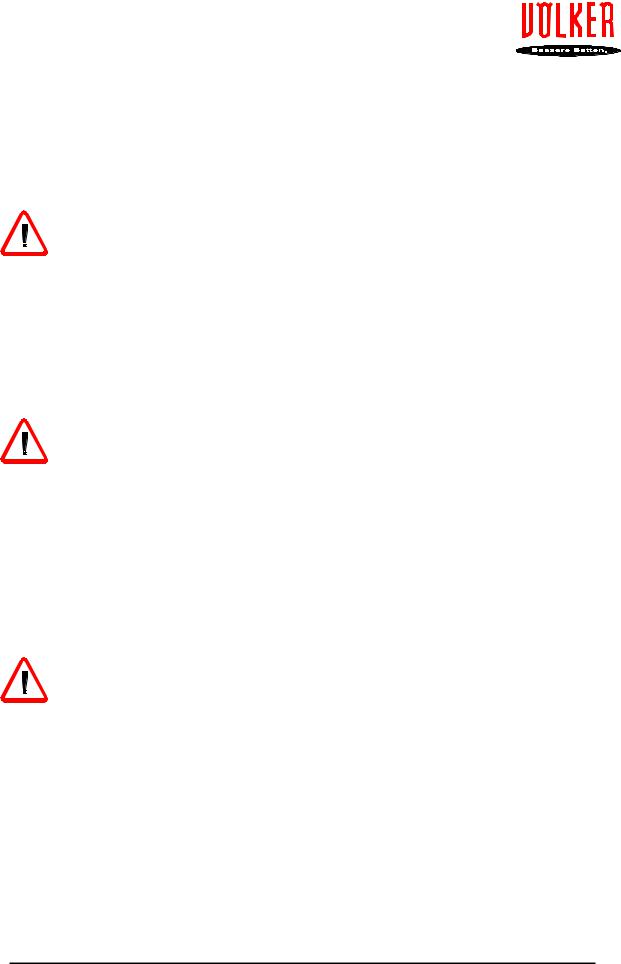
Völker hospital bed |
User’s Manual |
Model S 960-1 |
|
|
|
|
|
1. Safety regulations
These regulations must be read and strictly obeyed!
1.1.German medical products law (MPG) §22, Section 1
The hospital bed may only be put into service, operated and used a) as intended by the manufacturer, b) in accordance with the provisions of the medical products law (MPG) and its enacted statutory instruments, c) with due regard to good technical practice and d) in accordance with safety and accident-prevention regulations. On no account may the bed be used in a faulty condition that could endanger patients, carers or others.
The hospital bed may only be operated by those able to guarantee its correct handling by virtue of their professional qualifications, knowledge and/or experience.
1.2. Intended use
Völker S 960-1 hospital beds are intended to be used solely for the care of patients in patients’ rooms in hospitals, clinics and/or nursing institutions.
The care of patients under 12 in the S 960-1 hospital bed is permitted only when accompanied by appropriate safety measures, eg the use of protective safety frame covers.
Any use of Völker hospital beds that deviates in any way whatsoever from this intended use is expressly excluded from possible liability claims.
1.3.Incorrect use
The incorrect use of the bed can be a source of danger. Examples of incorrect use are:
•incorrect operation of electrical functions and unsupervised positioning,
•use of hospital bed with children under 12,
•operation of hospital bed by patients without prior instruction,
•simultaneous operation of electrical functions by different people,
•constant operation of keyboard (‘piano playing’),
•connecting electrical devices to bed which are not suitable for the purpose intended (subject to management’s duty of care),
•moving bed by pulling on cable,
•disconnecting electric plugs by pulling on cable,
•using bed on sloping surfaces with gradients in excess of 10° (bed brakes designed for a maximum gradient of 10°),
•trying to move bed with brakes applied,
Edition: 2002 May.-C
Page 7 of 80

Völker hospital bed |
User’s Manual |
Model S 960-1 |
|
|
|
|
|
•transporting patients by towing or pushing bed with a vehicle,
•using bed with loads in excess of specified maximum safe working load.
Edition: 2002 May.-C
Page 8 of 80

Völker hospital bed |
User’s Manual |
Model S 960-1 |
|
|
|
|
|
1.4.General safety instructions
CAUTION!
Refer to user’s manual!
Please read safety instructions!
WARNING! – Serious injury can be caused when moving powered parts of the bed. Make absolutely sure that there are no parts of the body poking through the safety frames during electrical operation. Ensure without fail that there are no people, pets or objects beneath the bed.
WARNING! – Increased safety measures are necessary when the bed is being used … 1. … by a child under 12 years of age,
2. ... by a person with reduced mental faculties, 3. ... for psychiatric purposes.
WARNING! – Automatic mode should not be selected when the bed is being used … 1. … by a child under 12 years of age,
2. ... by a person with reduced mental faculties, 3. ... for psychiatric purposes.
WARNING! – In order to avoid falls, always return the bed to lowest position after each use of the adjustment functions. Make absolutely sure that
a)the bed is in lowest position before getting into or out of it, and
b)the brakes are applied.
WARNING! – Safety frames only mark the limits of the bed. Other appropriate measures must be used to restrain patients.
WARNING! – Children under 12 and people with reduced mental faculties may only occupy Völker beds when the safety frames are covered by protective covers. Risk of injury. Refer to user’s manual.
WARNING! – In order to minimise risk of injury, the following permitted mattress sizes must be strictly observed. If you are not using Völker mattresses, please contact your Völker authorised dealer.
Mattress-size |
Mattress-frame size |
88 x 210 x 12 cm |
90 x 210 cm |
88x 200 x 12 cm |
90 x 200 cm |
88 x 197x 15 cm |
90x 200 cm |
88 x 207 x 15 cm |
90 x 210 cm |
Edition: 2002 May.-C
Page 9 of 80
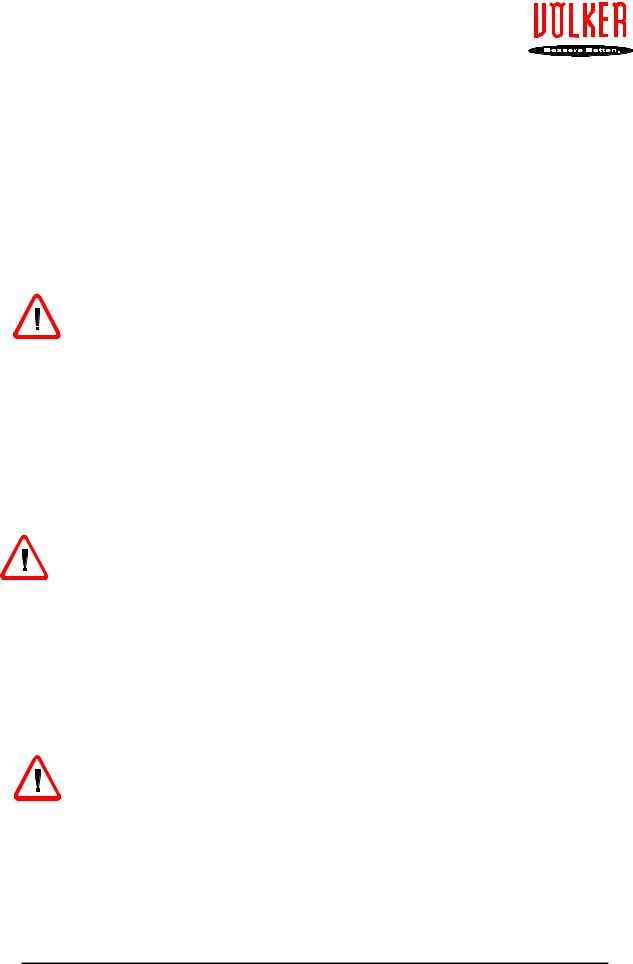
Völker hospital bed |
User’s Manual |
Model S 960-1 |
|
|
|
|
|
WARNING!
Make sure that the cable does not get caught in moving parts.
WARNING!
>Only use original spare parts for repairs.
>Only repair bed when it is in lowest position.
>Pull out power plug before repair or cleaning.
Refer to user’s manual and maintenance manual for further safety instructions.
1.5.Electromagnetic/-static interference
To ensure protection against electromagnetic and electrostatic interference (EMV), the S 960-1 hospital bed fulfils all the requirements of the relevant sections of the German medical products law (MPG).
−
−
Basis of testing for:
high-frequency interference: limiting values according to: limiting values according to:
resistance to jamming:
EN 60601-1-2:1993
EN 55011 Group 1, Class B:1998 EN 55014:1993
EN 60601-1-2:1993
1.6. Before using the bed for the first time
Before the bed is put into service for the first time, this user’s manual must be closely read by all those responsible for nursing care.
Before the bed is put into service for the first time, it is absolutely essential to carry out a functional test as described in Chapter 8.
Before first use, carers must receive detailed instructions in the operation of the bed. In addition, carers must be made fully aware of potential dangers that can arise in spite of the correct operation of the bed (see Chapter 4).
1.7.Checking the operational safety and condition of the bed
Before putting the bed into service, it is essential to make absolutely sure that it is in good working condition and safe to use. This test must not only be carried out before first use, but continuously throughout the service life of the bed. If necessary, the bed must be tested daily or after each shift to ensure that its use does not endanger anybody. To reduce maintenance to a necessary minimum, the bed should be cleaned, disinfected and tested as soon as possible after each use so that it can be used again without delay or risk (see Chaper 8, Functional test). Please note that preparation in a cleaning plant offends against this principle (see Chapter 9).
In cases of malfunctioning, it may be necessary to transfer the patient to another bed.
Edition: 2002 May.-C
Page 10 of 80
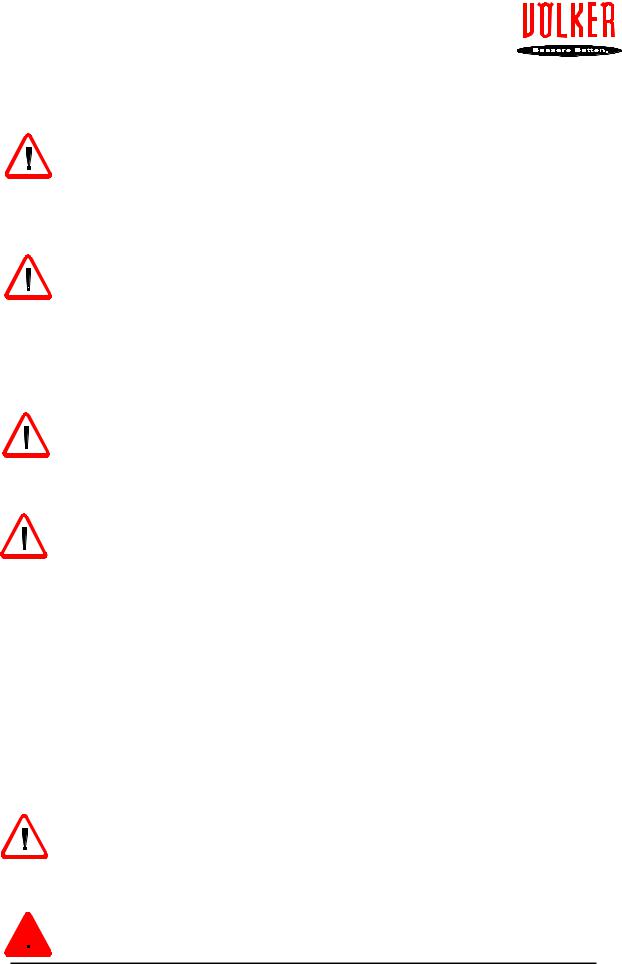
Völker hospital bed |
User’s Manual |
Model S 960-1 |
|
|
|
|
|
1.8.Position of the hospital bed – Danger of falling out of bed
In the case of unsupervised patients, we recommend that the bed is put into its lowest position to minimise the risk of injury due to falling out of bed. In other cases, it should be put at a height proportionate to the size of the patient.
1.9.Four-castor central braking system – Caution! Risk of accident
Unless in transport, the brakes must always be applied so that patients can use the bed as a support when accessing or exiting it. Serious falls can result through an unbraked bed rolling away. After applying the brakes, check that the bed is really immobile, ie that the brakes are fully applied to all four castors.
Height adjustment – Risk of entrapment between bed-frame and chassis
When adjusting the bed, make absolutely sure that no limbs, bedding or other objects are situated between the bed-frame and the chassis.
1.10. Safety frames – Risk of entrapment
In the case of patients whose physical or mental state may be felt to call for the use of safety frames to protect them from falling out of bed, the following safety measures must be observed at all times:
1.Safety frames may be operated only by carers instructed in their use.
2.Make sure safety frames – or elements of them – are either fully raised and locked or fully lowered.
3.During the electrical adjustment of the mattress-frame, make sure that the patient is not touching the safety frames. Also make absolutely sure that no limbs are poking through the frames.
4.If the safety frames are being used to protect a child or a person whose physical state may make their use appropriate, then make sure that the handset is out of reach. We also recommend the use of safety frame covers.
Failure by carers to obey these safety rules may cause hæmatoma or other injury to hands, knees, fingers, feet, shins and hips through entrapment.
1.11.Cleaning and disinfection
 Risks can arise through the incorrect cleaning and/or disinfection of the bed.
Risks can arise through the incorrect cleaning and/or disinfection of the bed.
Edition: 2002 May.-C
Page 11 of 80

Völker hospital bed |
User’s Manual |
Model S 960-1 |
|
|
|
|
|
1.12. Service and maintenance
The S 960-1 bed requires very little maintenance. All moving parts of the lifting gear, mattress-frame drives and safety frames are permanently lubricated during manufacture. None of these parts need relubrication when the bed is correctly used and cleaned. The manufacturer assumes, however, that beds are regularly inspected and damage such as worn parts, loose screws or fractures are immediately put right. For further information, please see the maintenance section of this user’s manual.
Edition: 2002 May.-C
Page 12 of 80
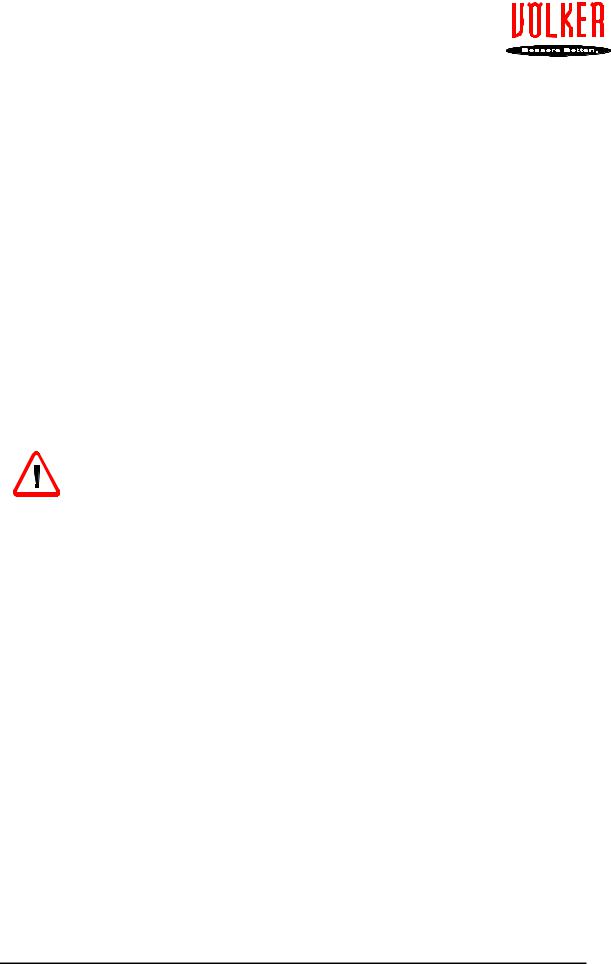
Völker hospital bed |
User’s Manual |
Model S 960-1 |
|
|
|
|
|
2. Definitions and technical description
2.1. Definitions
In the following text, “Völker” means “Völker AG”.
In the following text, “Völker bed” or “Völker hospital bed” means the S 960-1 hospital bed.
In the following text, “patient” means a person who is in the bed, or accessing or exiting it.
“Due care” means that all activities involving the bed in any way must guarantee the safety and freedom from harm of patients, carers and others.
In the following pages, the bed and its operation are explained and described with the help of photos and drawings.
Exceptionally important information in the technical desription is marked by this symbol:
= Warning
This information is to be read and obeyed without fail.
Edition: 2002 May.-C
Page 13 of 80

Völker hospital bed |
User’s Manual |
Model S 960-1 |
|
|
|
|
|
Technical description
Dimensions: Mattress-frame: |
90 cm x 210 cm |
||
|
Height adjustment: 40 cm – 80 cm depending on castors used |
||
Exterior dimensions: |
Length: |
227 cm |
|
|
|
Width: |
98 cm |
Net weight of bed: 146 kg |
|
|
|
Safety: |
Classification according to MDD 93/42/EWG (MPG) Class 1. |
||
|
Electrical protection: Safety category II/type B (body). |
||
|
Appliance with internal energy storage device 24V. |
||
Designed and constructed according to the latest definitive guidelines and harmonised standards; with CE Declaration of Conformity; complies with following specification:
European guideline 93/42/EWG, Appendix 1 (MPG) for medical products, with standards conformity according to:
DIN EN 60601-1 (VDE 0750 Teil 1):1996-03 – Electric medical appliances, Part I : General directive on safety (German version EN 60601-1: 1990+A1: 1993+A2: 1995; IEC 601-1:1988+A1:1991+A2:1995);
DIN EN 60601-1-2 (VDE 0750 Part 1-2): 1994-09 – Electromagnetic compatability (EMV) (German version EN 60601-1-2:1993; IEC 601-1-2:1993)
DIN EN 60601-1-4 (VDE 0750 Part 1-4): 1997-07 – Programmable electric medical systems (German version EN 60601-1-4:1996; IEC 601-1-4:1996);
DIN EN 60601-2-38 (VDE 0750 Part 2-38):1998-01 – Special directive on the safety of electrically-powered hospital beds (German version EN 60601-2- 38:1996; IEC 60601-2-38:1996).
Construction: IP X5, optional IP X6. Entire construction low-maintenance; all functions and control encased; chassis corrosion-free aluminium, impactresistant, burnt-enamal powder-coated according to Völker colour card.
All other assemblies aluminium, special plastic or equivalent material; headboard, footboard and castors according to Völker colour card.
Frame with sturdy fenders; 4 horizontal wall buffer wheels at each corner, 2 vertical wall buffer wheels at head end. Trapeze pole fixing location; standardised, variable full-length slide-bar for accessories on both sides of bed beneath mattress-frame.
Chassis: The entire lifting gear and carriage is housed in a sealed, distortionresistant metal casing according to IP X5. Floor-clearance of 40 cm provides
Edition: 2002 May.-C
Page 14 of 80

Völker hospital bed |
User’s Manual |
Model S 960-1 |
|
|
|
|
|
adequate leg room for carers and space for (eg) bed jacks. Smooth, uncluttered surfaces without plastic snap-in covers make for easy and effective cleaning.
Distortion-free aluminium construction; 2 18 V motors, lifting capacity 350 kg;
electrically-powered fourfold telescopic height adjustment from ca. 40 cm to ca. 80 cm, depending on choice of castors;
lateral synchronisation control for automatic correction of deviations in parallel operation of lifting gear and when returning from trendelenburg and/or reverse trendelenburg positioning; horizontal or vertical deviation is also less than 10 mm when carrying out reanimation or ergotherapeutic procedures.
Trendelenburg/reverse trendelenburg to a max. 14°/12°; comfortable sitting position selectable at any height via carers’ keyboard.
150 mm single castors with sealed, permanently-lubricated bearings, increased fracture-resistance even under heavy diagonally-exerted loads; streak-free tyres electrically conductive and easily removable for cleaning; 4-castor central braking system operated via brake-bar at foot of bed to block or release castors. Straight-ahead/track setting of one castor at head or foot of bed as required by care services, also via brake bar.
Mattress-frame: Four-section aluminium-profile mattress-frame with removable inlays for easy cleaning and drying (antistatic, chemical-resistant and UV-stable), according to recommendations of German Professional Nursing Association (GPNA). All mattress-frame sections interconnected and electrically conductive, voltage compensator socket on headend cross-member. Fixings for securing mattress on each side of movable sections.
Electrical adjustment of all mattress-frame positions via three separate motors; back section adjustable to 75°; automatic back section length compensation according to recommendations of GPNA; mattress-frame design according to recommendations of GPNA; to protect patients, minimum angle of back and upper leg sections 90°; electrical adjustment of cardiac, comfortable-sitting and horizontal lower leg positions; manuallyoperated emergency release of back section (CPR), cushioning mechanism for jerk-free descent.
Quick removal of headboard/footboard by means of fast-release fixing; electrical trendelenburg/reverse trendelenburg positioning via carers’ keyboard, LED display for optimal adjustment. Four safety frame elements integrated into mattress-frame, horizontally extended also usable as depository for bedding and as support for special therapeutic positions, when raised suitable for use as support when accessing or exiting the bed.
A total of three drives is available for mattress-frame positioning, ie for back, upper leg and lower leg sections. Motors in sealed casings below central bearer. Max. standard preset back rest angle 75°.
Easy access to drives for servicing and safety checks.
Bent-knee position (comfortable sitting position) and horizontal lower leg position selectable via carers’ keyboard and patient’s handset; during adjustment to horizontal lower leg position, simultaneous automatic
Edition: 2002 May.-C
Page 15 of 80

Völker hospital bed |
User’s Manual |
Model S 960-1 |
|
|
|
|
|
repositioning of leg section. Full horizontal lower leg position possible by putting upper leg section at 75°.
Mattress displacement device according to GPNA:
The mattress displacement device or length compensator automatically shifts the fulcrum of the back section 15 cm backwards when it is being raised. This stops patients sliding down the bed and concertinaing against the footboard, especially when both back and leg sections are being adjusted simultaneously. The compensator creates a kinæsthetic space that stimulates patient mobility.
Fast-release facility:
The back section can be rapidly lowered (CPR) as required simply by releasing the retaining mechanism on the mattress-frame. The facility is fitted with a cushioning device to ensure jerk-free descent. No resetting is needed to reinstate normal back section operation after fast release.
Safety frames:
The S 960-1 is equipped with split safety frames on both sides of the bed that are fully integrated into the mattress-frame. When raised, they both protect the patient and serve as a support when accessing or exiting the bed. When not in use, they are pushed out of sight beneath the mattressframe. This facilitates the unobstructed fitting of accessories and the use of a bed-jack even when the bed is in lowest position. During mattress-frame adjustment, the safety frames are repositioned automatically. To use, pull the safety frames horizontally out of their locations. To protect the patient, they are then raised either singly or together and locked into position. Complete patient protection is achieved by raising all four safety frame. Thanks to their exceptional stability, they can also by used as a depository for bedding or as support for special therapeutic positioning, eg physiotherapy. This stability also stimulates patient mobility by providing reliable support when sitting up and exiting the bed. As in the case of many S 960-1 functional features, here too the variety of possible configurations pays off. Hence the back section can be used to help the patient sit up, and the telescopic jack to put the bed at the ideal individual height for exiting it. As an option, the height of the safety frames can be increased by 12 cm, eg when using special mattresses. In this way, the minimum required height of 22 cm between mattress and the upper edge of safety frames can always be maintained. During transport, the safety frames – in whatever position – act as robust anti-impact side-fenders. In the case of the S 960-1, this avoids the usual damage to door-frames or to the safety frames themselves.
Lengthening the bed:
An extension piece mounted on telescopic slides enables the bed to be lengthened by 20 cm without removing the footboard (optional). The extension piece is securely fixed to the lower leg section of the mattressframe and is simply pulled out of its location and folded up, as required.
Edition: 2002 May.-C
Page 16 of 80

Völker hospital bed |
User’s Manual |
Model S 960-1 |
|
|
|
|
|
Fast removal of headand footboard:
The headand footboard can be removed as required by means of a fastrelease fixing built into the bed-frame. Easy handling at all times is ensured by the use of plastic connectors with an exceptionally long service life. As the connectors are not subject to crevice corrosion, they do not split and hence tend to clamp even after being washed many times.
Fixings for trapeze pole and drip-feed stands:
Push-in sleeves for trapeze poles and drip-feed stands are provided on the outside of the headend of the bed.
Fixings for accessories and therapeutic appliances:
Adapters fitted to the full-length slide bars on each side of the bed accept therapeutic appliances and care accessories. These can be positioned as required simply by pushing them back and forth along the slide bar. Easy positioning is guaranteed independently of bed height and safety frame configuration.
Wall buffer wheels:
In addition to the safety frames acting as side-fenders during transport, there are also horizontal buffer wheels on all corners of the bed and two further vertical buffer wheels at the headend.
Accessories: Völker offers a wide range of accessories for its beds.
You will find the complete range in our hospital accessories brochure.
Edition: 2002 May.-C
Page 17 of 80

Völker hospital bed |
User’s Manual |
Model S 960-1 |
|
|
|
|
|
Electrics and
control: Processor control, integrated energy storage device (battery), all functions operable without mains power supply, 230 V mains connection on battery charger, from there and within bed safe low voltage (24 V) – no electrosmog.
Carers’ keyboard with all mattress-frame positions and height adjustment, plus trendelenburg/reverse trendelenburg function, activation/deactivation of patient’s handset functions, including graphic display. Functions that stimulate the autonomous mobility of patients, ie height adjustment and mattress-frame positioning, can be selected by patients themselves via separate handset (unbreakable; IP X5 as standard or IP X6 for decontamination plants).
Handset for patients with the following functions:
− |
Back section |
up/down |
− |
Upper leg section |
up/down |
− |
Lower leg section |
up/down |
− |
Height adjustment |
up/down |
− |
Comfortable sitting position |
|
Handset can be mounted to right or left, as required; an optional handset connection is also available on safety frame.
Operational readiness independently of mains supply is ensured by means of a rechargeable battery. An integrated power-saver (eco-mode) means that the bed remains operational over long periods out of service. In normal operation, the bed can be used for about 2 days with a fully-charged battery. When used as instructed, the service life of the batteries is at least 5 years. Spent batteries are returned to Völker for recycling.
The use of an external 400 mA charger and an internal energy storage device ensures that only safe low voltage current flows from the battery charger (in the socket) onwards. The bed is fitted with an infrared port for maintenance purposes
Cleaning: If required, a version of the bed can be supplied that is suitable for cleaning in decontamination plants. Follow the recommendations in brochure ZH 1/200 to ensure a long service life and functional efficiency.
Edition: 2002 May.-C
Page 18 of 80
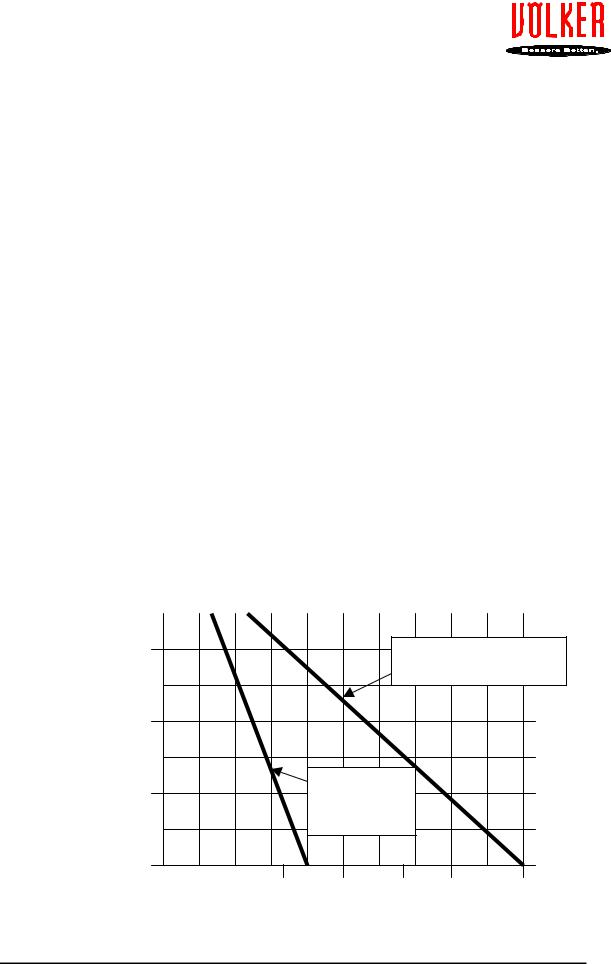
Völker hospital bed |
User’s Manual |
Model S 960-1 |
|
|
|
|
|
Maintenance
and care: Uncluttered surfaces and encased working parts make the
S 960-1 exceptionally easy to clean. It is suitable for cleaning by spraying and wiping with commercial disinfectants and cleaning agents. Follow the recommendations in brochure ZH 1/200.
All sub-assemblies are in stainless steel and hence require little maintenance. Inspection checks are only necessary at 12-month intervals. Bar-code and inventory number for technical inspections can be integrated. We also run training sessions for in-house technical staff, if required.
Warranty: 2 years warranty on construction and working assemblies.
Ecological
data: Fitted with a device (24 V safe low voltage, internal energy storage device) to hinder the formation of electrosmog.
All packing materials are removed on delivery and taken back free of charge. We also guarantee to take back the bed itself for ecologicallyappropriate utilisation/disposal.
Service life of hospital beds:
With the exception of parts subject to wear and tear, eg castors and electronic components, the bed has a service life of about 12 years providing that it is used, cleaned, serviced and repaired as instructed. Cleaning and/or disinfection in mechanical plants can reduce the above service life, depending on frequency.
Methods of cleaning
Preparation in decontamination plant more than 1 × daily
Preparation in decontamination plant 2 × weekly
Weekly preparation in decontamination plant
Manual preparation by wipe/spray disinfection
|
|
With conscientious |
||
|
|
care and maintenance |
||
|
Without care |
|
|
|
|
and |
|
|
|
|
maintenance |
|
|
|
5 |
7.5 |
10 |
12 |
15 |
Service life (years)
Edition: 2002 May.-C
Page 19 of 80

Völker hospital bed |
User’s Manual |
Model S 960-1 |
|
|
|
|
|
3. Explanatory notes for carers
This documentation contains all information necessary for the normal operation of Völker hospital beds.
Völker accepts no guarantee claims whatsoever for damage, injury or accidents caused by carelessness, inattentiveness or the incorrect use of the Völker hospital bed. In this connection, the question of culpability is irrelevant.
If required by the customer, Völker or its representative is willing to give carers basic training in the operation of the bed.
The participation in such training sessions for carers must be confirmed with name, date and signature on a form specifically intended for this purpose, which must be counter-signed by Völker or its representative.
The safety regulations contained in this documentation – more especially those in Chapter 2 – must be strictly obeyed and adhered to at all times.
The conscientious observance of the safety regulations, modes of behaviour and instructions described in this manual guarantees the safety of carers, patients and others.
Please note that functional features marked as special equipment are only available in beds so equipped.
Edition: 2002 May.-C
Page 20 of 80
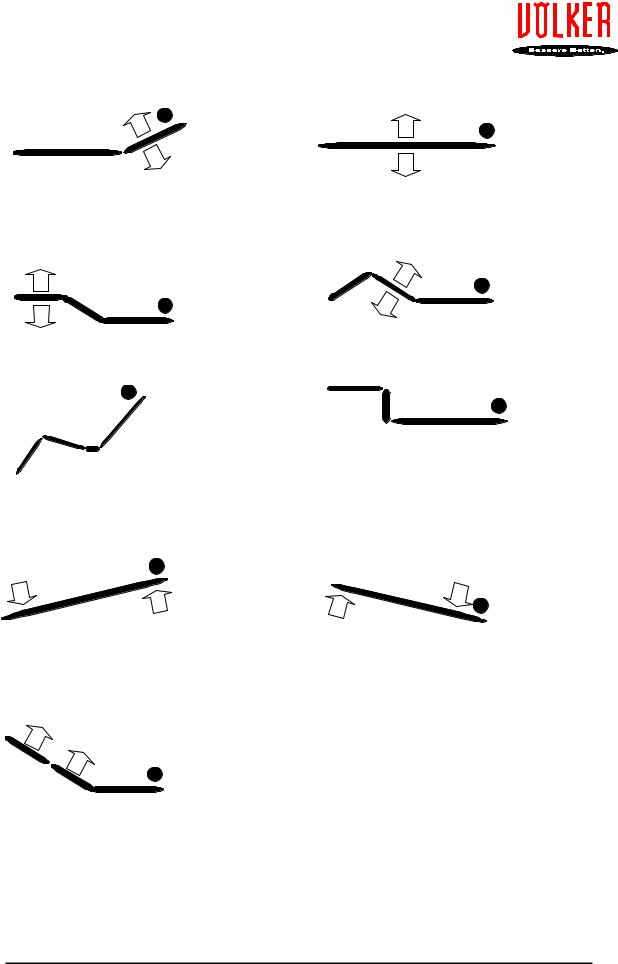
Völker hospital bed |
User’s Manual |
Model S 960-1 |
|
|
|
|
|
4. Review: Types of patient positioning
RAISED BACK SECTION |
FLAT POSITION, height adjustment |
RAISED LOWER LEG SECTION |
RAISED UPPER LEG SECTION |
SITTING POSITION |
FULLY HORIZONTAL LOWER LEG POSITION |
REVERSE TRENDELENBURG POSITIONING |
TRENDELENBURG POSITIONING |
(FOOT RIGHT DOWN) |
(HEAD RIGHT DOWN) |
SHOCK POSITIONING
Edition: 2002 May.-C
Page 21 of 80

Völker hospital bed |
User’s Manual |
Model S 960-1 |
|
|
|
|
|
5. Operational units
General operating instructions
5.1.1. Safety class
The bed conforms to Safety Class II and Type B according to DIN EN 60601-1 and VDE 0750, Part 1.
The bed is fitted with a connection for a voltage compensator.
The electricity supply via the charger is safety insulated and is equipped with a fail-safe transformer that charges the battery with electrical energy.
5.1.2. Operating interval
The maximum operating interval of the electrically-powered bed functions is given on the bed (name plate) and/or in the technical data sheet as “Int 2 min / 10 min”, ie each bed function may only be continuously operated for a maximum of 2 minutes in any period of 10 minutes.
Automatic safety devices kick in if the maximum operating interval of 2 minutes is repeatedly or markedly exceeded, leading to the power drives cutting out. The bed must then be inspected and tested!
An integrated time-lag device hinders the accidental or brief operation of the keyboard and consequent movement of the mattress-frame. This device requires that users consciously press and hold down the relevant key. Functions then kick in after a time-lag of ca. 0.5 seconds.
5.1.3. Batteries
When fully charged, the bed batteries have a theoretical capacity sufficient to power all bed functions with a working load of 170 kg continuously for ca. 15 minutes. After that, only the emergency functions (trendelenburg/reverse trendelenburg) and booting can be carried out.
If the bed is put into storage with disconnected charger, then self-discharge through leakage leads to the exhaustion of the battery!
Totally discharged batteries can be so badly damaged as to necessitate their premature replacement!
In order to achieve a long service life, the correct treatment of both the battery and the charger is absolutely essential!
5.1.4. Built-in safety cut-out
The bed is fitted with a built-in electronic safety cut-out that hinders the overloading of the drives. In the event of overloading, the drives are automatically switched off. For safety reasons, thereafter electrical adjustment is only possible in the opposite direction.
This adjustment in the opposite direction is also required if the drive is already in end-position!
After having been moved in the opposite direction, normal adjustment of the mattressframe is automatically reinstated.
Edition: 2002 May.-C
Page 22 of 80
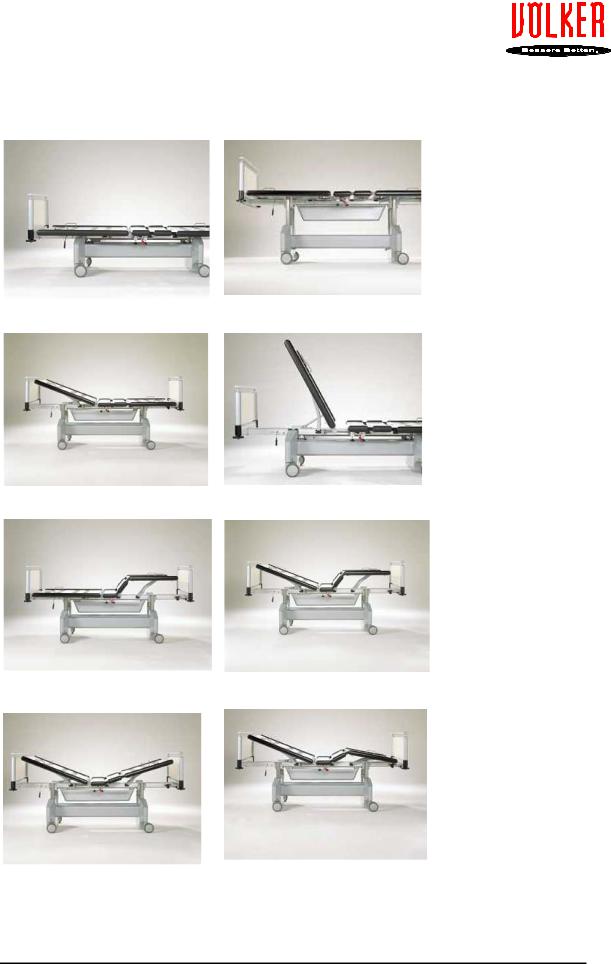
Völker hospital bed |
User’s Manual |
Model S 960-1 |
|
|
|
|
|
5.2. Review: Bed functions
Height adjustment
Back section adjustment
Upper leg section adjustment
Lower leg section adjustment
Edition: 2002 May.-C
Page 23 of 80
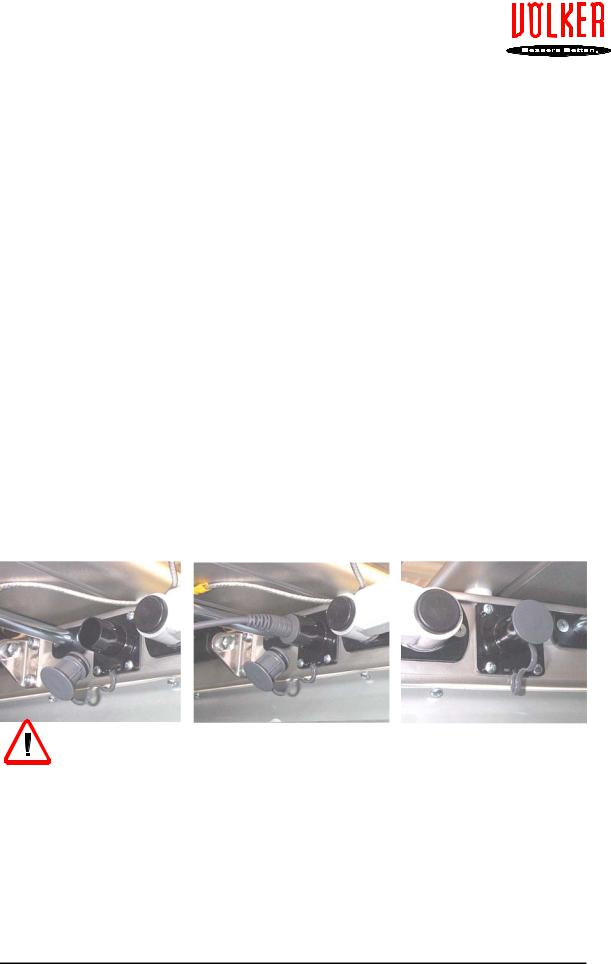
Völker hospital bed |
User’s Manual |
Model S 960-1 |
|
|
|
|
|
Puting bed into service for the first time (initiation)
Location
The bed is authorised for use solely in dry rooms (Technical data sheet). A mains power supply socket and, if required, a voltage compensator connection must be available in the room in which the bed is to be used.
The bed is mobile without the need for auxiliary transport equipment.
The bed may only be moved on firm surfaces. Moving the bed over obstacles greater than 2 cm in height is prohibited. Gradiants may not exceed an angle of 10°.
The bed is supplied complete and can be set up without first having to remove transport equipment.
5.2.1. Mechanical initiation
•Push the headand footboards supplied into the corner connectors of the bedframe.
(see 5.3.10)
•Handset connection
There is a socket for the handset on the LH and RH face of the central bearer below the seat section. Pull off the protective cap and insert the handset plug. Make sure that the socket that is not in use always remains sealed with the protective cap!
If the handset is removed from the bed, then the socket must immediately be resealed with the protective cap (maintenance of safety standards IP-X5 or IP X6).
Edition: 2002 May.-C
Page 24 of 80
